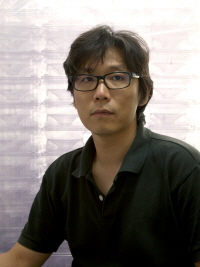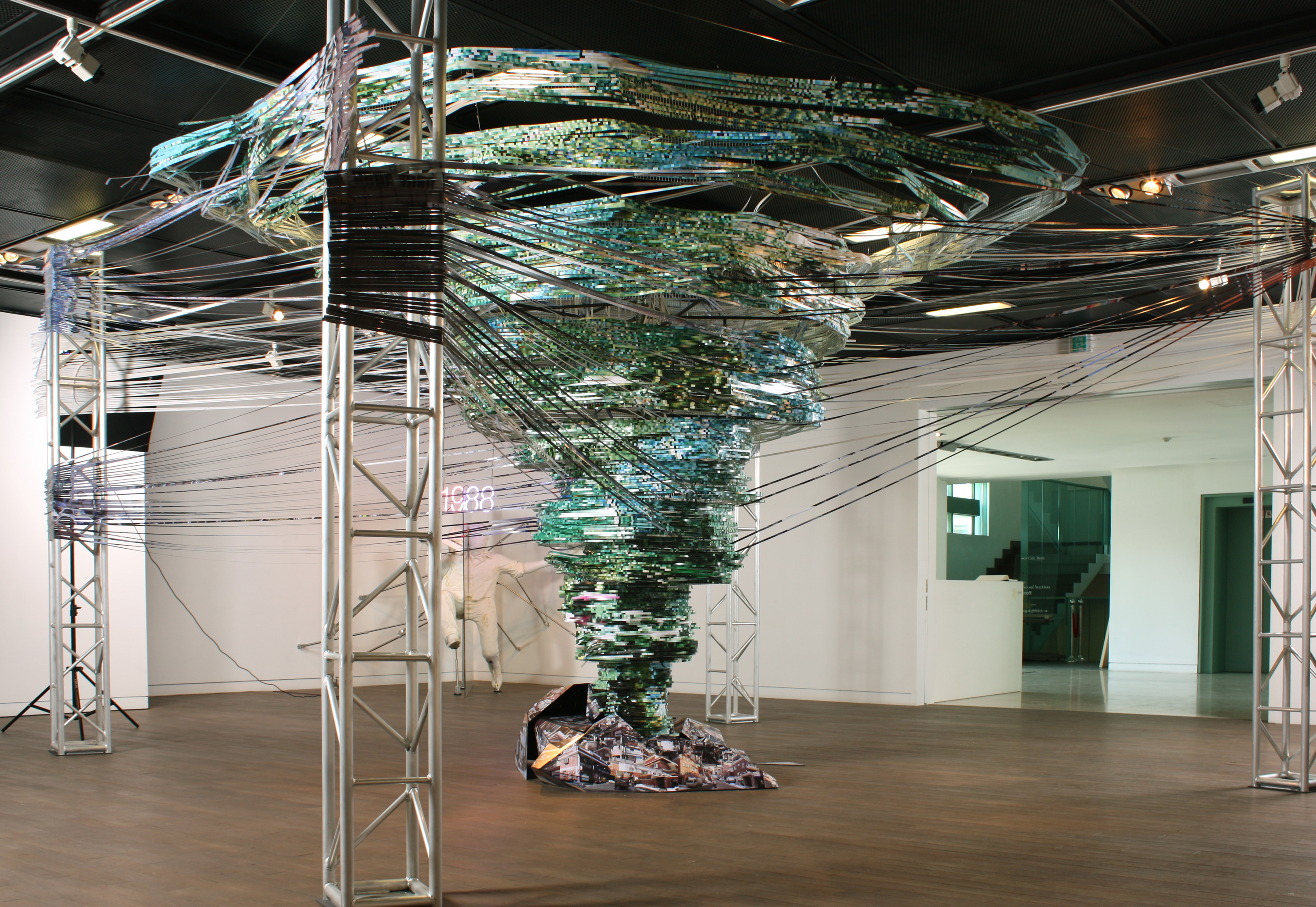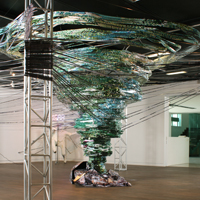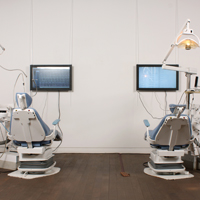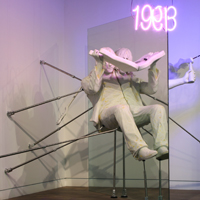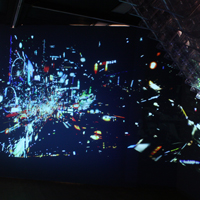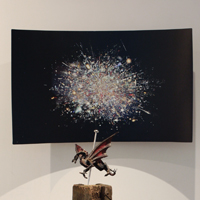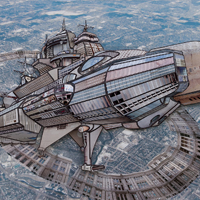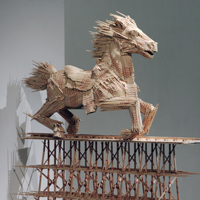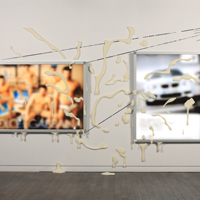Return of Laocoon
Youngmin Kang built Chinese Troyan Horse out of bamboo chopsticks made in China. He got inspiration for it from Chinese workers who immigrated to America and built the Central Pacific Railroad in the 1860s, after the California gold rush. It eventually joined the Union Pacific Railroad at Promontory Summit, Utah, forming the first transcontinental railroad of the United States. The Chinese immigrant workers had fled desperate conditions in their homeland in the waning years of the Qing dynasty to do this hazardous construction work through the Rocky Mountains and the Sierra Nevada Mountains. They were called coolies and shed sweat and blood in the worst working conditions at low wages. The transcontinental railroad constructed with their sacrifice changed the course of history itself, not to mention the industry and distribution of the population of the United States.
This horse galloping across what is obviously a train tressle made of disposable chopsticks like Cheollima ("thousand-mile horse"), the Korean name for a mythical horse, reminds us of the countless coolies who died during the railroad construction, while leading us to think about frailty of civilization. The construction of the railroad would have been impossible without exploitation of cheap labor and racial discrimination against immigrant workers, and this causes us to ponder the barbarism of civilization versus the Native Americans of the American West who lost their lands and were forced onto reservations during the modernization of America.
The Troyan Horse exists not only in Homer's Illiad but in our times also.
The Troyan Horse is well known for ending the grinding ten-year war between the Greeks and Troy. However, it would be fair to argue that the Trojans were responsible for their own destruction for not being aware of the true nature of the wooden horse rather than Troy was destroyed by brave and agile Greek warriors hidden inside. The Trojans’ fighting spirit began to fail after their greatest leader, Hector, fell in battle, and they dragged the wooden horse into Troy as if they had been hypnotized by Odysseus. Learning that the Greeks would never conquer the citadel unless they could remove the horizontal lintel stone of the Scaean Gate, Odysseus ordered his army to build the wooden horse slightly higher than the lintel. The Trojans fell for Odysseus's ruse and removed the lintel stone to allow the horse into the city. This rendered Troy defenseless against the Greek attack at night, and Troy was destroyed. The idea that a horse sloppily made with wood could have collapsed Troy, which had held hegemony in the eastern Mediterranean, may sound romantic, but the legend of the Troyan Horse shows that even an impregnable wall has a weak point. This is also true of Achilles, the most valiant Greek warrior in the Trojan War: he had a weak point, too. The Troyan Horse symbolizes a formidable and destructive ruse that exploits such weak point.
It is obvious that the modern city is systematically organized and functionally ubiquitous. The city is an intense monumental achievement of civilization that is the product of all man’s science and technology. The city is also something like the Tower of Babel, which can collapse depending on internal and external factors. A modern city of spatial expansion and spectacles is a factory that manufactures and consumes desires, and it is a combat arena of hyper-reality where things visible and invisible intermingle. Kang Young Mean's Tornado in Seoul depicts one certain aspect of such hyper-reality in a city as a visible landscape. This scene of a tornado is an assemblage of motion picture film of newly constructed buildings. The photo images of the newly constructed buildings were broken down by pixel unit and reassembled and strips of film were connected to produce the all too familiar funnel-shape of a tornado, and it is almost impossible to identify the original photos. All that viewers can understand is that the image at the bottom in atypical form that supports the installation structure is a composite of photos of scenes of not yet developed regions. The cut out scene of a city that fills strips suspended between scaffolds almost suggests the future of a city constructed in haste. Come to think of it, Gravity Zero Kang produced in 2007 with styrofoam was the result of his imagination of dystopia, reminiscent of an image of a collapsed city which he had witnessed when he was a student in fine art college. Truly, when Kang was in the early twenties, Korea was a 'republic of disasters' as can be seen in tragic incidents beyond imagination such as the Gupo train derailment in 1993, the collapse of the Seongsu Bridge in 1994, and the collapse of Sampoong Department Store in 1995. Although the landscape of Seoul changed dramatically as a result of 'progress without interruption' during the years of government-led economic development run amok, the grand finale of the ‘republic of civil engineering’ had already been foreshadowed in the collapse of the Wawoo Apartment Complex in April 1970. Looking at Kang's urban landscape depicting overpasses intersecting modernist buildings, the first thing that came to my mind were the Seongsu Bridge and Sampoong Department Store, and I thought that the sense of crisis I felt would not be exaggerated worries and that there should be others who felt the same way as I did.
Mikhail Bakunin (1814-1876), a well-known Russian theorist of collectivist anarchism, is often quoted as saying: “The passion for destruction is also a creative passion.” Although in different context, if we look at the construction process of a city in modern times, Bakunin's statement seems very true. The passion for destruction is also a constructive passion. To construct one thing, something else should be destroyed. Thus, a city becomes a massive round-the-clock construction site. The city built on destruction promotes a fantasy of pleasant, convenient, and well organized space for people. However, the collapses of a seemingly safe bridge and a concrete building we believed would last one hundred years, and frequent car accidents jar us into the realization that reality is cruel and that our belief in 'the millennium' is extremely unfounded. One-time accidents can be prevented and God can be blamed for natural disasters, whereas problems that are the results of established structures that serve human desires explode all at once and we are forced to deal with them without any time to complain at all. The explosion on April 26, 1986 at the Chernobyl Nuclear Power Plant in the Ukrainian SSR (now Ukraine) was simply a result of human error, but the aftereffect was devastating and remains so to this day. In Japan, it is obvious that the earthquake and huge tsunami caused the meltdown of the Fukushima Nuclear Power Plant, but it is doubtful that the meltdown was entirely due to the earthquake. Notwithstanding the nuclear scares the Japanese experienced when the first atomic bombs were dropped on Hiroshima and Nagasaki, and the Daigo Fukuryu Maru, a Japanese tuna fishing boat that was exposed to nuclear fallout from the United States' Operation Castle Bravo hydrogen bomb test in 1954, Japan concentrated on nuclear power generation and supplied electricity generated by a nuclear power plant to the Osaka World Exposition in 1970. Before the Fukushima nuclear disaster, the Japanese had become blinded by the myth that nuclear energy is safe, even in the face of the partial meltdown at the Three Mile Island Nuclear Generating Station in the US in 1979 and the global spread of radioactivity from the Chernobyl explosion in 1986. Such disasters cause us to duly consider the numerous structural problems. I wonder if Japan built the power plant so close to the sea out of excessive concern with construction cost. Perhaps they wanted to use the sea as the cooling system and did not anticipate such a great earthquake, with the result that they did not properly maintain the cooling system. Another possibility is that Japan adhered to practical reasoning of supplying electricity to a city today and surreptitiously leaving the issue of handling of nuclear waste to the next generation. Or perhaps Japan postponed alternative energy development to replace nuclear development due to short-term economic considerations? Even a layman like me cannot stop wondering.
With too many nuclear power plants for its small landmass, Korea is also in danger of experiencing nuclear disasters. The Japanese people have been suffering tremendously since the explosion of the Fukushima nuclear power plant, and Korea is probably even more vulnerable to nuclear disasters compared with Japan, especially since South Korea confronts North Korea and Korea's energy consumption is excessive compared with the famously frugal Japanese. Whatever the case, a city is a place of opportunities and at the same time a dangerous place. Kang presents a collapsing city to reveal the indifference hidden behind our optimism. As if our vulnerable skin were bleeding or festering because of a small wound, Kang's work shows that the skin and nerves that constitute a city also can suffer trauma by even only a small blow or a shock from outside.
Let's go back to the Troyan Horse at this point. The Troyan Horse was a blessing to Greece but a disaster to Troy. Could the ten-year war have been ended that easily by only a wooden horse? If we are not overwhelmed by Homer's imagination, we can consider other factors. The Turkish seaside where the Troy citadel was located is vulnerable to earthquakes. During a period of ten years of exhausting war, the possibility of an earthquake leveling the walls of Troy is non-negligible. Such a calamity would have allowed the Greeks to rush the city and destroy whatever was left of it. Could the Greeks have accepted such an earthquake as a blessing from Poseidon for their war effort, and could this be the true basis of the legend of the 'Trojan Horse'? The Greeks could have interpreted the situation as Poseidon riding a horse from the sea. Seen from the Trojan side, the wooden horse was a curse from God and punishment for not being prepared for disaster. Laocoon, a Trojan priest of Poseidon, anticipated disaster but could not prevent it. If we understand Laocoon as someone with imagination and foresight, Kang's works can be said to be similar to the warning of Laocoon.
Even so, we cannot define Kang as an artist with a negative perspective who attacks a city and the fantasy that the city has always created. Focusing his attention on a city, he not only presents a dystopian landscape of a city but attempts to comprehend the city by entering the city through joint works. Kang organized a group called Walkmate and carried out a project called City Cleaning in his efforts to expand the scope of his works shown at the exhibition at White Cube to urban space and to more directly address everyday living in a city. This project was based on a true story about a woman who became a full-time housewife and mother after she quitted her job as a stock market analyst on Yeouido, the Wall Street of Korea. The idea of cleaning a city is reminiscent of performance art by the High Red Center, a Japanese avant-garde group, shown with the opening of the 1964 Summer Olympics in Tokyo. However, the intention of Walkmate was to clean the city for young analysts who would walk across the intersections of the financial district. Thus, they intended to understand a city through the act of cleaning the city as if they were cleaning and embracing something valuable. Kang says city cleaning can be approached from two different perspectives. First, cleaning can change the topography and context of urban space completely, as in redevelopment, that is, a specific district is swept cleanly to be rebuilt. In this case, the city becomes larger, more refined, and cleaner through massive public works and architecture, but the history of the district and life of the people living there are swept away with the cleaning. Kang’s alternative was 'cleaning for communion with things,' that is, cleaning streets as an expression of resisting and opposing redevelopment and expansion of the city. Walkmate has been carrying out a project focusing on process rather than results: when they discover a typical fixture of a city like a mailbox while cleaning the city, they extend their work to the mailbox.
The concept of 'meta polis' suggested by Kang shows that his interest can be extended to ecology beyond reclamation of a city. In other words, Kang is seeking the potential of the next level of meta polis, which is based on pluralism and revival of regionality. It remains to be seen how his idealism can be materialized in his works, but I expect his worries about ecology, the environment, and reconstruction of sustainable urban space thus far will serve as a foundation for him to develop and produce optimistic and tolerant artworks instead of the negative and critical works he has done thus far.
As the Trojan Horse did not exist from the first, it should not return. But we need someone like Laocoon. An artist should talk about problems, as Laocoon did. Instead of the wooden horse, it is Laocoon that should return.
Choi Tae-man, Art critic
more
Serious Critique, Playful Expression
Kang Youngmin’s 2009 work titled, Reconstruction-Seoul was a notable example that best represented the artist’s aspirations. Through this work the artist persuasively illustrates the bizarre isolation of “inhabitants of contemporary metropolis Seoul who harbor complex and hectic relationships, whose existencea are reduced to a mere pixel.” There is always a subtext on the problematics of civilized society in Kang Youngmin’s artwork. There is a sincere recognition and analysis of the bizarre reality that we live in, the barbarism disguised as civilization, and the isolation of humans and objects that are all infused into his imagery.
His methodology of expressing his serious inquiry and critical perspective is dramatic, sensitive, and playful rather than austere or tragic. A diverse range of methods, such as, spectacle, dramatic emphasis, sarcastic innuendo, paradox, deconstruction, synthesis of imagery, and conflict are employed to fine tune the weight of his messages. Accordingly, the words of the late Paik Nam June that art needs to be “fun” comes to mind--an emphasis on the significance of maintaining pleasure and a fun attitude even when reflecting social and historical problems. For instance, in Kang Youngmin’s work installting a cooler in a refrigerator or air-conditioner, artist's notion of generating heat in order to cool the heat, is a parody on the self-contradictory discrepancies that abounds today. In this work, the internal mechanisms exposed like intestines and the wrecked lubricator are messages to awaken and recognize the perilous imbalance of our social order which supports our society and economic system. Whether it is a plastic container or the historical context of the Defense Security Command site, Kang Youngmin slightly twists or reverses his subject matter to reflect on our times and society.
As the artist himself states, his methodology is related to the artist’s “transfer from artist-centered romanticsm towards artwork-centered savvy.” After all, the artist is recognizing the fact that the venue where the work is shown, be it a museum or gallery, is not the heated site where real events are played out. Therefore a staged approach is more apt as exhibiting space, and this recognition has also influenced the makeup of his work. Nonetheless, the fine tuning manipulation between his methodology of expressing “fun” and his dramatic presentations of social inquiry is ever more vital.
Kang Youngmin is not limited to painting, which he majored in college, but freely engages sculpture, a variety of interactive media, and installation. An artistic genre should be a range of possibilities and not a set of regulations or restrictions. His resistance against confinement to one position and Kang Youngmin’s engagement with a variety of visual material is also another strong potential of this artist. This flexibility is also apt to his approach of “pressing towards the fundamentals of the truth in this world by deconstructive analysis.”
Sang Yong Shim (Doctor of Art History at Dongduk Women's University)
more






